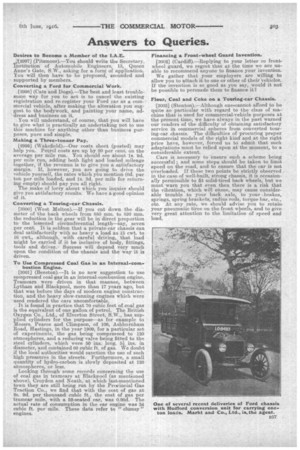Answers to Queries.
Page 21

If you've noticed an error in this article please click here to report it so we can fix it.
Desires to Become a Member of the LA.E.
42997] (Pitsmoor).—You should write the Secretary, tastitution of Automobile Engineers, 13, Queen Anne's Gate, S.W., asking for a form of application. You will then have to be proposed, seconded and supported by members.
Converting a Ford for Commercial Work.
[2998] (Cats and Dogs).—The best and least troublesome way for you to act is to cancel the existing registration and re-register your Ford car as a commercial vehicle, after making the alteration you suggest to the bodywork, and painting your name, ad' dress and business on it.
You will understand, of course, that you will have to give what is practically an undertaking not to use this machine for anything other than business purposes, pure and simple.
Making a Three-tonner Pay.
[2999] (Wakefield).—Our costs sheet (posted) may help you. Petrol costs are up by 20 per cent, on the average per mile run. You should see about is. 9d. per mile run, adding both light and loaded mileage together, if the revenue is to give you a satisfactory margin. If, however, you are going to drive the vehicle yourself, the rates whieh you mention (6d. per ton per mile loaded, and 1s. 3d. per mile for returning empty) should pay you all right.
The make of lorry about which you inquire should give you satisfactory results. We have a good opinion of it.
Converting a Touring-car Chassis.
[3000] (West Melton).—If you cut down the diameter of the back wheels from 880 ram. to 820 mm. the reduction in the gear will be in direct proportion to the lessened circemferential length—say, seven per cent. It is seldom that a private-car chassis can deal satisfactorily with so heavy a load as 15 cwt. to 16 cwt., although, with careful driving, that load inight be carried if it be inclusive of body, fittings, tools and driver. Success will depend very much upon the condition of the chassis and the way it is driven.
To Use Compressed Coal Gas in an Internal-combustion Engine.
[3001] (Beeston).—It is no new suggestion to use compressed coal gas in an internal-combustion engine. Tramcars were driven in that manner, between Lytham and Blackpool, more than 17 years ago, but that was before the days of modern engine eonstruetion, and the heavy slow-running engines which were used rendered the cars uncomfortable.
It is found in practice that 70 cubic feet of coal gas is the equivalent of one gallon of petrol. The British Oxygen Co., Ltd., of Elverton Street, S.W., has supplied cylinders for the purpose—as for example to Messrs. Pearce and Clinipson, of 106, Ashhurnham Road, Hastings, in the year 1909, for a particular set of experiments, the gas being compressed to 120 atmospheres, and a reducing valve being fitted to the steel cylinders, which were 50 ins. long', 532ins, in diameter, and contained 60 cubic ft. of gas. We doubt if the local authorities would sanction the use of such high pressures in the streets. Furthermore, a small quantity of hydro-carbon is slowly deposited at 120 atmospheres, or less.
Looking through some records concerning the use of coal gas in tramcars at Blackpool (as mentioned above), Croydon and Neath, at which last-mentioned town they are still being run by the Provincial Gas Traction Co., we find that with the cost of gas at 2s. 9d. per thousand cubic ft., the cost of gas per tramcar mile, with a 52-seated ear, was 0.95d. The actual rate of consumption in the ear engine was 34 cubic ft. per mile. These data refer to " clumsy" engines. Financing a Front-Wheel Guard Invention.
[3002] (Cardiff).—Replying to your letter re front, wheel guard, we regret that at the time we are unable to recommend anyone. to finance your invention.
We gather that your employers are willing to allow you to attach it to one or other of their vehicles. If the invention is so good as you say, would it not be possible to persuade them to finance it?.
Flour, Coal and Coke on a Touring-car Chassis.
[3003] (Stenton).—Although oneNcannot afford to be quite so particular with regard to the class of machine that is used for commercial-vehicle purposes at the present time, we have always in the past warned our readers of the difficulty of obtaining satisfactory service in commercial spheres from. converted touring-ear chassis. The difficulties of procuring proper commercial models of the right kind and at the right price have, however, forced us to admit that such adaptations must be relied upon at the moment, to a considerable extent.
Care is necessary to ensure such a scheme being successful; and some steps should be taken to limit speed on the road, and to ensure that the car is not overloaded. If these two points be strictly observed in the case of well-built, strong chassis, it is occasionally permissible to fit solid-tired back wheels, but we must -warn you that even then there is a risk that the vibration, which will ensue, may cause considerable trouble to your hack axle, to your brakes, springs, spring brackets, radius rods, torque bar, etc., etc. At any rate, we should advise you to retain, your pneumatic tires on the front wheels, and to give very great attention to the limitation of speed and load.






















